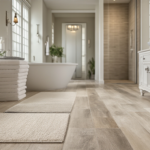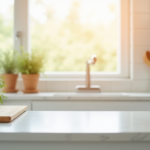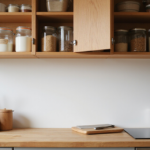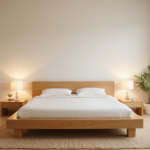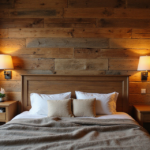Imagine stepping into a kitchen where every morning feels like a gentle embrace – where weathered wood tells stories, soft fabrics catch the light, and the scent of fresh herbs mingles with coffee brewing. This is the magic of a cottage kitchen, a space that prioritizes soul over sleekness and comfort over convention. It’s where imperfections become character marks and where every element whispers of home.
The cottage kitchen aesthetic celebrates the beauty of lived-in spaces, embracing natural materials, gentle colors, and thoughtful details that accumulate over time. Unlike stark modern designs, these kitchens feel collected rather than purchased, curated through years of loving use rather than a single shopping trip. They’re spaces that invite you to linger, to bake bread on Sunday mornings, and to gather friends around mismatched chairs for impromptu conversations.
Creating your own cottage kitchen doesn’t require living in a centuries-old farmhouse or having an unlimited budget. It’s about understanding the elements that make these spaces so enchanting: the interplay of texture and color, the balance between function and beauty, and the art of making new pieces feel like treasured finds. Whether you’re working with a galley kitchen in the city or a sprawling country space, these design principles can transform any cooking area into a haven of warmth and character.
Ready to infuse your kitchen with that coveted cottage charm? These 22 carefully curated cottage kitchen ideas will guide you through everything from foundational color choices to the smallest decorative details, helping you create a space that feels both timeless and uniquely yours.
1. Select a Warm, Inviting Wall Color Palette
The foundation of any enchanting cottage kitchen begins with choosing wall colors that immediately embrace you with warmth. Think beyond stark whites to explore the gentle spectrum of buttery yellows, soft sage greens, warm terracotta, and creamy off-whites that seem to glow from within. These hues don’t just paint your walls – they transform the entire atmosphere, making even the smallest kitchen feel like a sun-drenched haven where every meal preparation becomes a joy rather than a chore.
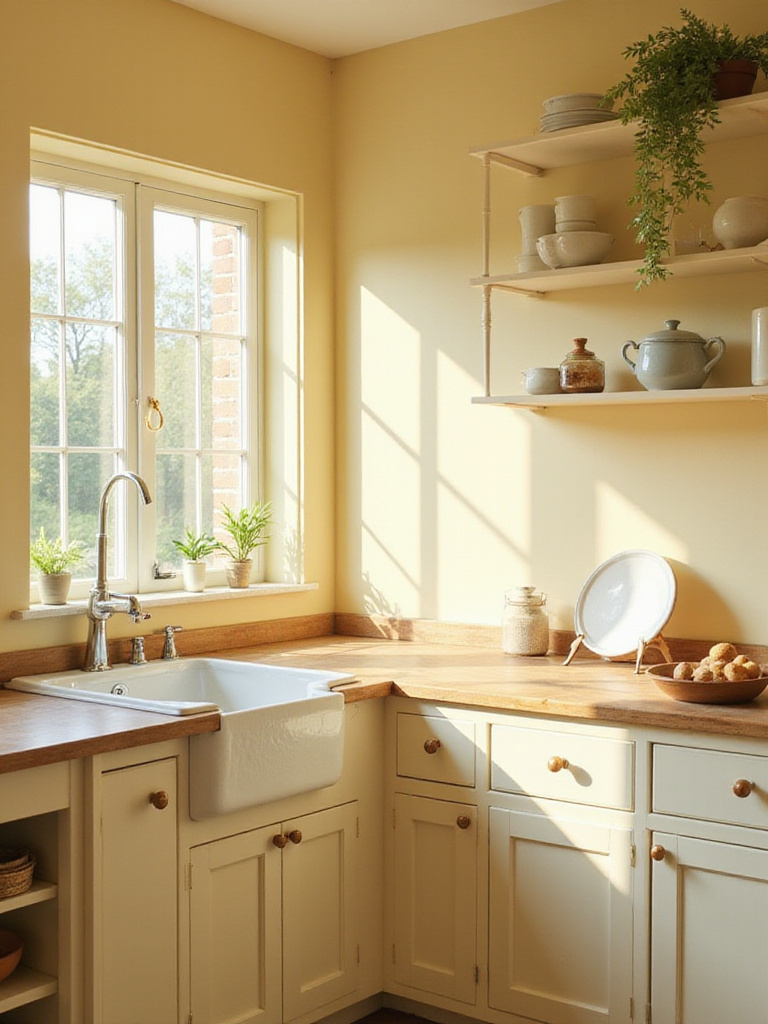
The psychological impact of warm colors in kitchens extends far beyond mere aesthetics. Studies consistently show that warmer color temperatures increase feelings of comfort and well-being, while also enhancing the natural light in your space by up to 60%. When you choose colors like soft yellow or warm sage, you’re not just decorating – you’re creating an environment that naturally lifts spirits and makes the kitchen the heart of your home. The key lies in selecting shades with the right undertones: a warm gray with hints of brown feels entirely different from a cool gray with blue undertones, and this subtle difference can make or break your cottage aesthetic.
As afternoon light streams through your windows, these warm wall colors become the perfect backdrop for the next essential element of cottage charm.
2. Brighten Your Space with Soft Pastel Cabinet Hues
Transforming your cabinets with gentle pastel hues instantly breathes new life into your kitchen while maintaining that essential cottage sweetness. Soft mint green, powder blue, buttery yellow, or blush pink cabinets reflect light beautifully, making your space feel larger and more welcoming. These colors work their magic by bouncing natural light around the room, creating an airy atmosphere that feels both cheerful and serene – exactly the emotional balance that defines cottage style.
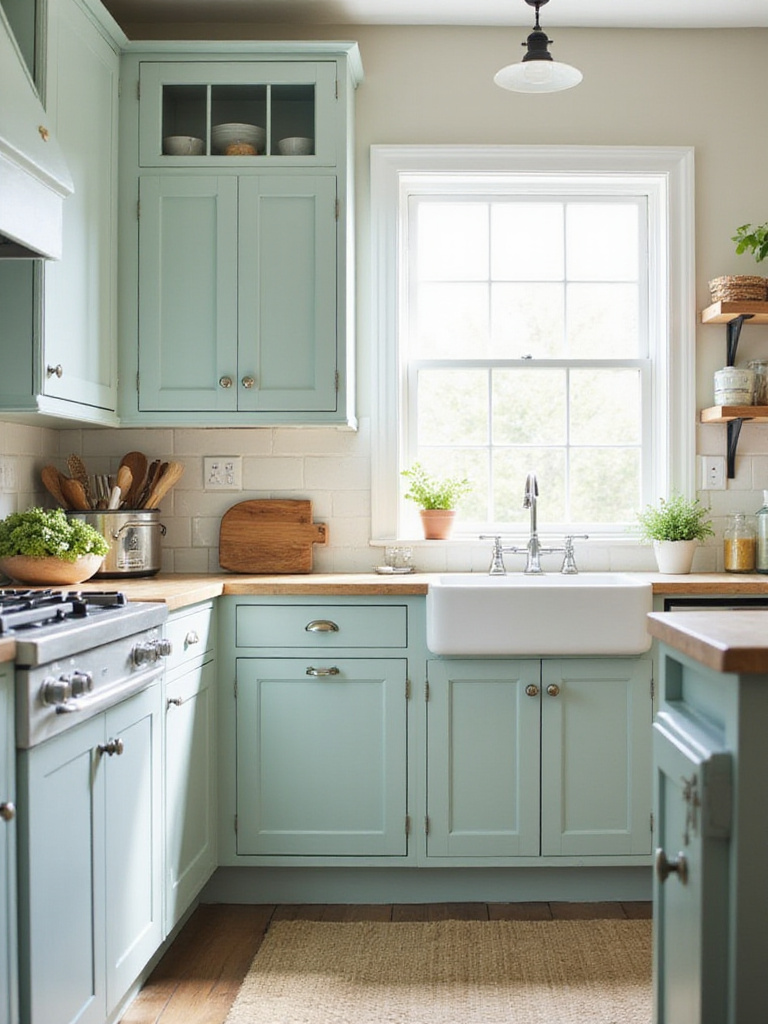
The beauty of pastel cabinets lies in their ability to add personality without overwhelming the senses. Unlike bold, saturated colors that can feel aggressive in a kitchen setting, pastels whisper rather than shout, creating a sense of calm that makes cooking and gathering feel more pleasant. When selecting your shade, pay careful attention to undertones – a mint green with gray undertones will feel more sophisticated than one with yellow undertones, while a soft blue with hints of lavender creates a different mood than one leaning toward green. The key is testing your chosen color in different lighting conditions throughout the day to ensure it maintains its charm from morning coffee to evening cleanup.
If replacing cabinets isn’t in your budget, the transformative power of paint can work wonders on your existing cabinetry.
3. Transform Existing Cabinets with a Fresh Coat of Paint
One of the most dramatic yet budget-friendly transformations you can achieve involves painting your existing kitchen cabinets. This single update can completely shift your kitchen’s personality, taking it from builder-grade basic to cottage charming for a fraction of the cost of replacement. The key to success lies in understanding that cabinet painting is 90% preparation and 10% actual painting – a truth that separates professional-looking results from disappointing DIY disasters.
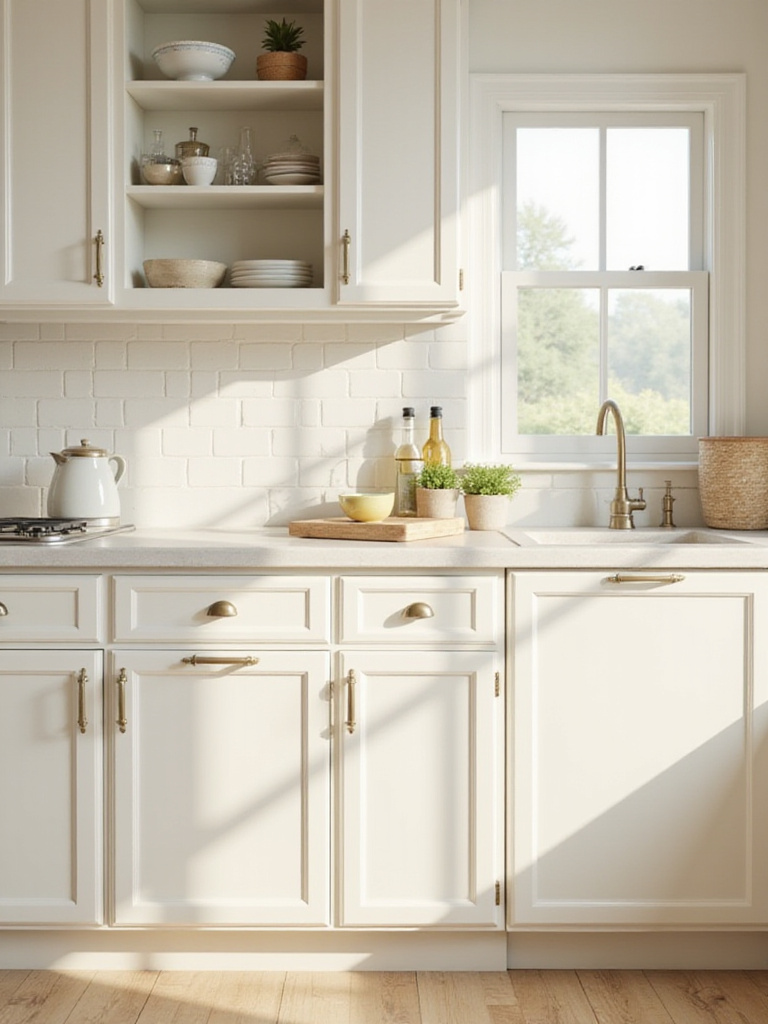
The process demands patience but rewards you with results that can increase your home’s perceived value by thousands while costing hundreds. Proper preparation includes thorough cleaning with a degreaser, light sanding to create tooth for the paint, and applying a high-quality bonding primer designed specifically for cabinets. The paint itself should be a durable cabinet-specific formula, applied in thin, even coats with adequate drying time between applications. Many homeowners rush this process and end up with paint that chips or feels tacky, but when done correctly, painted cabinets can look and feel as beautiful as new cabinetry while maintaining the character that makes cottage kitchens so appealing.
Beyond the cabinets themselves, adding architectural texture to your walls creates another layer of cottage authenticity.
4. Apply Beadboard Paneling for Instant Cottage Charm
Beadboard paneling serves as one of the most effective shortcuts to authentic cottage character, instantly adding the kind of architectural detail that makes spaces feel collected over time rather than decorated overnight. The vertical grooves create visual texture that breaks up flat wall surfaces while providing a durable, washable finish perfect for kitchen environments. Whether applied as wainscoting, a full wall treatment, or even as a backsplash alternative, beadboard brings that essential sense of craftsmanship and history that defines cottage style.
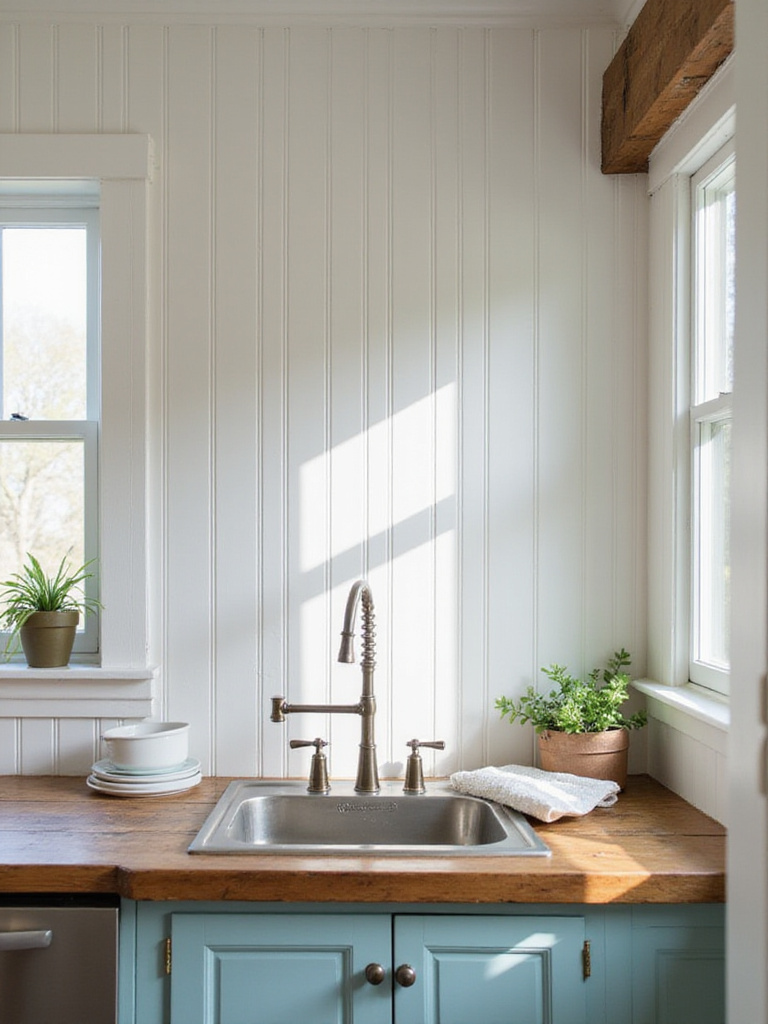
The installation process is surprisingly straightforward for DIY enthusiasts, but success depends on careful measurement and proper preparation. Choose between individual planks for the most authentic look or larger sheets for easier installation, keeping in mind that moisture resistance is crucial in kitchen applications. MDF or PVC beadboard offers better moisture resistance than natural wood, while still providing the classic look when properly painted. The key is ensuring your installation is level and properly secured to wall studs, then finishing with a semi-gloss or satin paint that can withstand kitchen humidity and frequent cleaning.
With your walls beautifully textured, the next step involves selecting a sink that serves as both a functional centerpiece and a style statement.
5. Install a Classic Farmhouse Sink for Timeless Appeal
A farmhouse sink with its distinctive exposed apron front instantly becomes the focal point of any cottage kitchen, combining substantial visual presence with exceptional functionality. The deep basin accommodates oversized pots and roasting pans with ease, while the forward-positioned design reduces back strain during daily tasks. More than just a practical fixture, a farmhouse sink anchors the entire cottage aesthetic, providing that essential sense of authenticity and craftsmanship that makes the space feel genuinely lived-in rather than styled.

Choosing the right farmhouse sink requires balancing material, size, and installation requirements with your specific needs and budget. Fireclay offers the most traditional look with excellent durability, though it can chip if subjected to heavy impacts. Stainless steel provides modern functionality with easier maintenance, while cast iron delivers classic appeal with superior heat retention. The installation process requires careful coordination with cabinetry and countertops, as the sink must be supported by a specially designed base cabinet and the countertop must be precisely cut to accommodate the apron front. This coordination is crucial – many homeowners make the costly mistake of ordering their sink before finalizing cabinet specifications.
What makes this collection special is the way each piece speaks to the timeless appeal of natural materials, particularly in creating functional workspace islands.
6. Add a Butcher Block Island for Prep and Gathering
A butcher block island transforms your cottage kitchen into a true gathering space, providing both essential workspace and a warm, natural focal point that draws people together. The rich grain patterns and honey-colored tones of quality hardwood create an inviting contrast to painted cabinetry while offering a surface that’s both beautiful and highly functional for food preparation. Unlike cold stone or synthetic materials, wood feels warm to the touch and develops a beautiful patina over time, telling the story of countless family meals and shared moments.
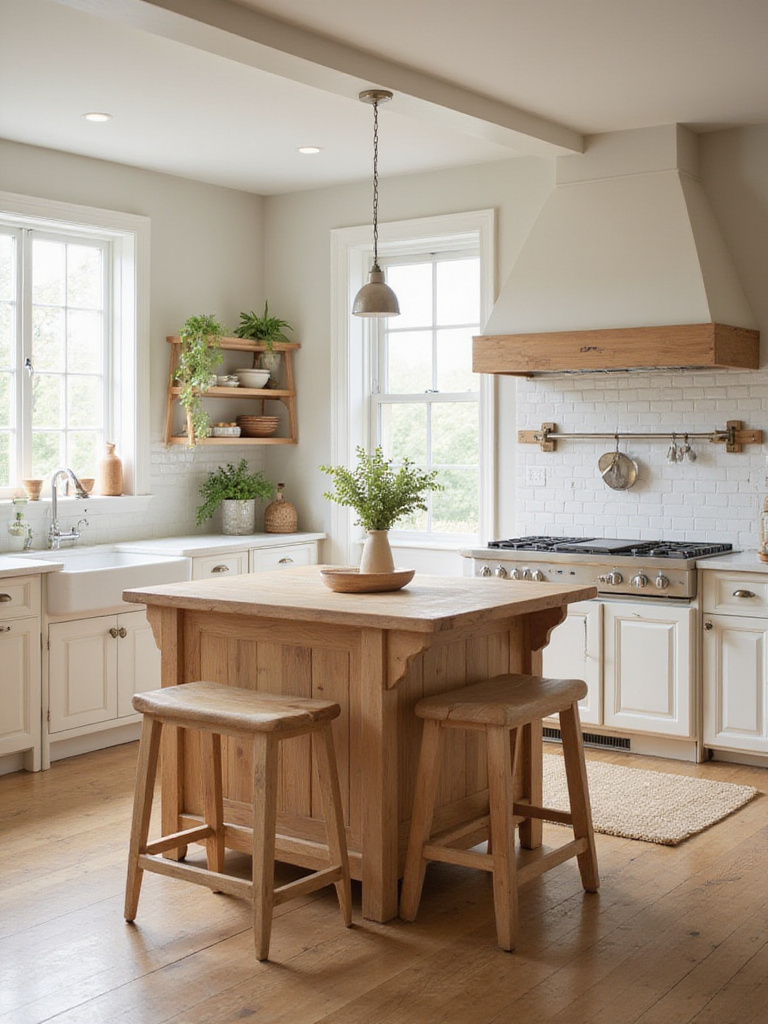
The practical benefits extend far beyond aesthetics – a well-designed butcher block island can increase your usable counter space by 6-10 square feet while providing valuable storage underneath. The natural antimicrobial properties of certain woods like maple make them excellent choices for food preparation, while the ability to sand and refinish the surface means your investment will last for decades. When planning your island, consider both fixed and mobile options: a wheeled cart offers flexibility in smaller spaces, while a permanent installation can incorporate electrical outlets, additional storage, and seating areas that make the island a true hub of kitchen activity.
The warmth that radiates from natural wood continues beautifully when extended to your flooring choices.
7. Warm Up the Floor with Natural Wood Planks
Natural wood flooring brings an irreplaceable warmth and character to cottage kitchens that synthetic materials simply cannot replicate. The organic variations in grain pattern, the subtle color differences between planks, and the gentle give underfoot all contribute to a sense of comfort and authenticity that makes your kitchen feel like a true home rather than a showroom. Wide-plank floors, in particular, create a sense of rustic elegance that perfectly complements the cottage aesthetic while making smaller spaces appear larger and more open.

Modern wood finishes have evolved to handle kitchen environments beautifully when properly applied and maintained. The key lies in selecting the right species for your needs – oak offers durability and classic appeal, while pine provides rustic charm at a lower cost, and reclaimed woods bring instant history and character. Proper sealing with multiple coats of polyurethane or specialized water-based finishes creates a barrier that protects against moisture while allowing the natural beauty of the wood to shine through. The investment in quality installation and finishing pays dividends in both daily comfort and long-term home value, as wood floors remain among the most desired features for homebuyers.
With beautiful flooring as your foundation, creating clean, classic lines on your walls becomes the next essential element.
8. Install a Subway Tile Backsplash for Clean Lines
Subway tile remains the gold standard for cottage kitchen backsplashes because of its remarkable ability to provide clean, timeless lines without competing with other design elements. The simple rectangular format and classic running bond pattern create visual order and continuity that allows your charming details – from vintage hardware to displayed collections – to truly shine. This understated elegance makes subway tile the perfect backdrop for a style that celebrates accumulated character rather than bold statements.
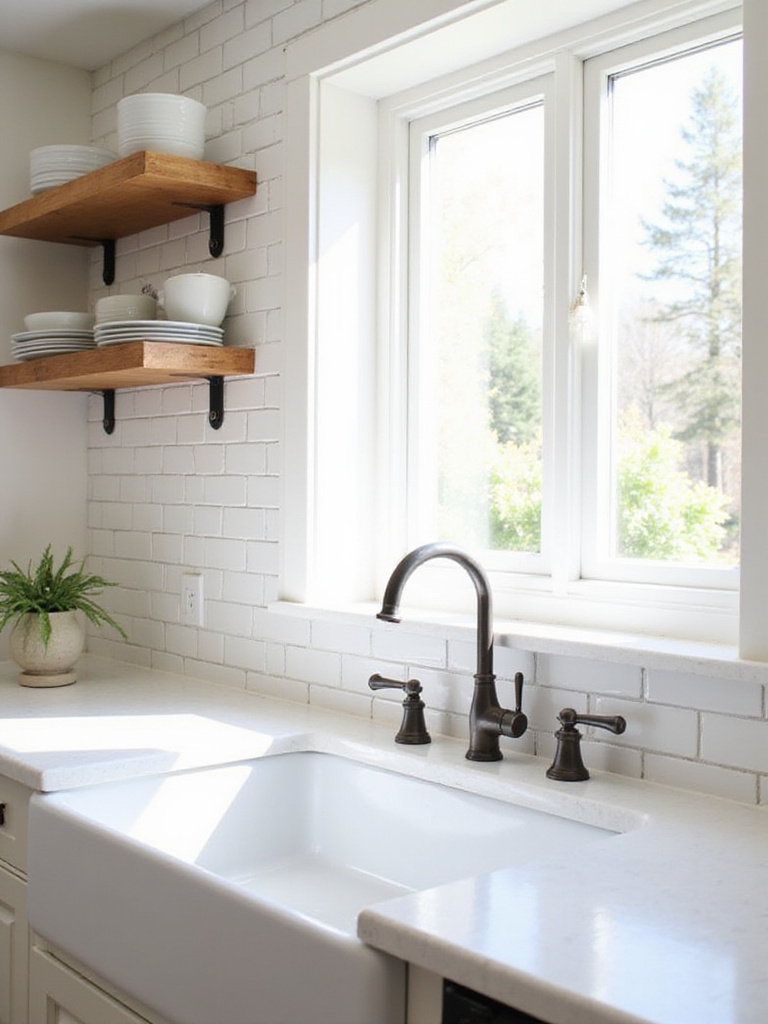
The enduring popularity of subway tile stems from its versatility and practical benefits as much as its aesthetic appeal. The smooth, non-porous surface cleans easily and resists stains, while the uniform pattern creates a sense of calm organization that makes kitchens feel more spacious and serene. When selecting subway tile for your cottage kitchen, consider variations beyond standard glossy white – handmade tiles with slight irregularities, matte finishes, or subtle color variations can add character while maintaining the clean lines that make this choice so effective. The installation process is straightforward enough for confident DIYers, but success depends on careful planning and precise execution of that crucial first row.
While clean lines provide the perfect foundation, adding character through carefully chosen hardware creates those essential personal touches.
9. Add Character with Vintage Cabinet Knobs and Pulls
Swapping standard cabinet hardware for vintage pieces instantly infuses your cottage kitchen with personality and history that new hardware simply cannot provide. These small details function like jewelry for your cabinets, transforming ordinary storage into charming focal points that tell a story. Whether you choose mismatched ceramic knobs with delicate floral patterns, aged brass cup pulls with beautiful patina, or glass knobs that catch and reflect light, vintage hardware adds layers of character that make your kitchen feel collected over time rather than purchased all at once.

The hunt for perfect vintage hardware becomes part of the joy of creating your cottage kitchen, as each piece brings its own history and character to your space. Antique stores, flea markets, and online marketplaces offer treasure troves of options, but success requires patience and careful measurement to ensure proper fit. The beauty of mixing different styles and finishes lies in creating that authentic “collected over generations” feeling that defines cottage style. Just remember to purchase a few extra pieces when possible, as finding exact matches later can prove challenging, and having spares ensures you can maintain your look even if pieces need replacement over time.
Once your cabinets showcase beautiful hardware, opening them up entirely creates opportunities for even more personal expression.
10. Showcase Charming Dishes on Open Shelving
Open shelving transforms your most beautiful dishes from hidden storage into living decoration, allowing your personality to shine through everyday items while maintaining easy access for daily use. The key to successful open shelving lies in thoughtful curation – selecting pieces that work together harmoniously while telling the story of your personal style. Stacks of creamy ironstone, collections of blue and white transferware, or mismatched vintage teacups all contribute to that collected-over-time aesthetic that makes cottage kitchens so appealing and personal.
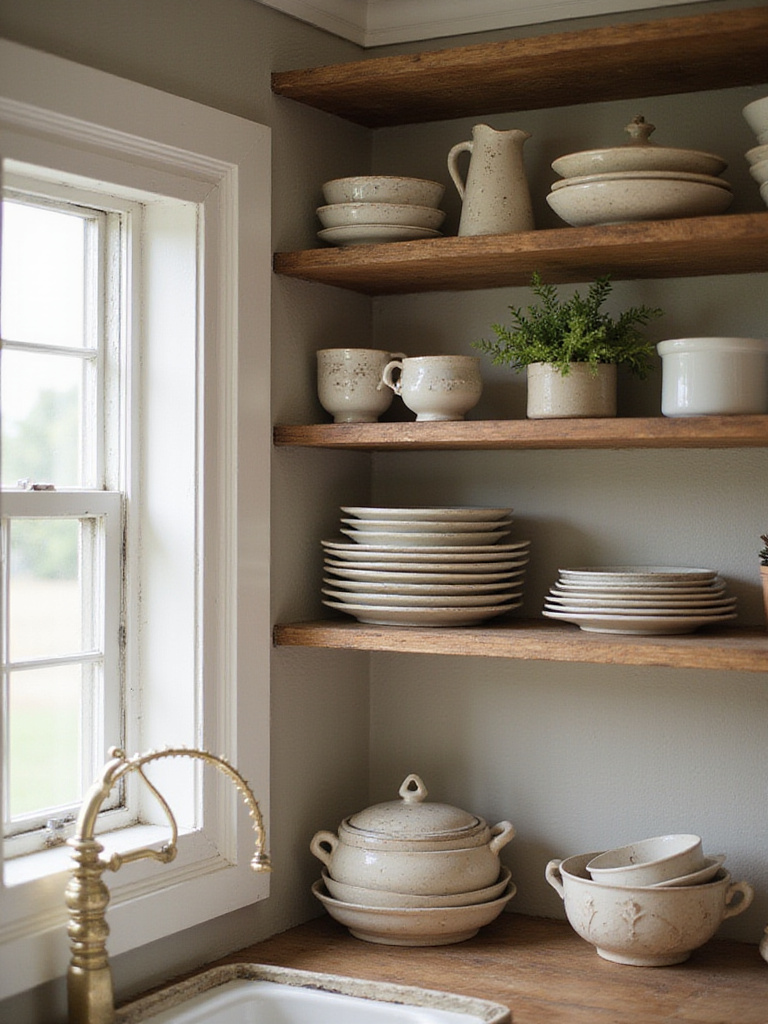
The art of styling open shelves involves balancing function with beauty, grouping similar items while varying heights and textures to create visual interest. Layer larger pieces like platters or cutting boards behind smaller items, incorporate a few non-dish elements like small plants or vintage cookbooks, and remember that negative space is just as important as the items themselves. The goal is creating vignettes that look effortlessly arranged rather than overly styled, achieving that perfect balance between practical storage and charming display that characterizes the best cottage kitchens.
Beyond displaying beautiful items, practical storage solutions can add texture while maintaining the organized charm essential to cottage style.
11. Use Woven Baskets for Accessible, Textured Storage
Woven baskets serve as the perfect marriage of form and function in cottage kitchens, providing essential storage while introducing natural textures that soften hard surfaces and add visual warmth. Made from materials like rattan, seagrass, or bamboo, these containers bring an organic element indoors while solving practical storage challenges. The beauty of baskets lies in their ability to contain clutter while remaining attractive enough to display openly, turning necessary storage into decorative elements that enhance your cottage aesthetic.
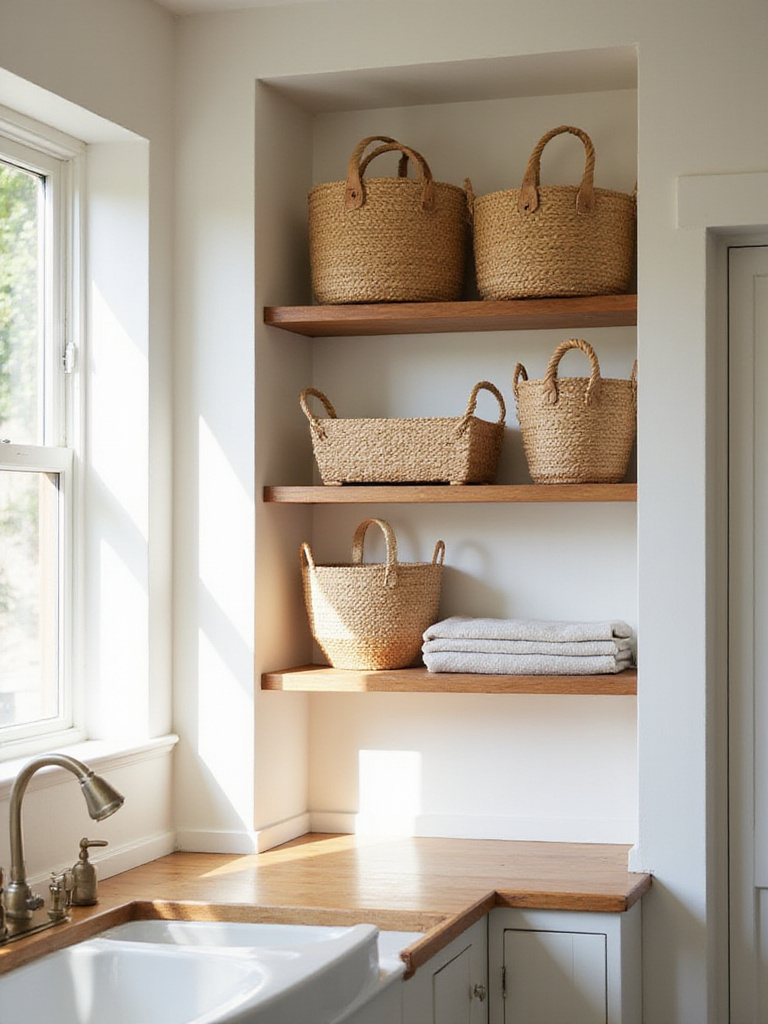
The versatility of woven baskets makes them invaluable for organizing everything from fresh produce and linens to small appliances and cleaning supplies. Unlike rigid storage containers, baskets adapt to their contents while maintaining their attractive appearance, and their portability allows you to reorganize and rearrange as your needs change. When selecting baskets for your cottage kitchen, consider varying sizes and shapes while maintaining consistency in material or color to create a cohesive look. The natural variations in handwoven pieces add to their charm, making each basket unique while contributing to that authentic, artisanal feeling that defines cottage style.
While baskets provide attractive storage above counter level, clever solutions below can hide necessary items with equal charm.
12. Hide Under-Sink Storage with a Fabric Skirt
A gathered fabric skirt around your sink base offers a delightfully cottage-appropriate solution for concealing under-sink storage while adding softness and color to your kitchen. This charming detail, reminiscent of traditional farmhouse and cottage kitchens, provides instant access to stored items without the expense of cabinet doors while introducing textile elements that warm up the space. The gentle folds and feminine touch of a sink skirt create a perfect counterpoint to harder kitchen surfaces, contributing to that cozy, lived-in feeling that defines cottage style.
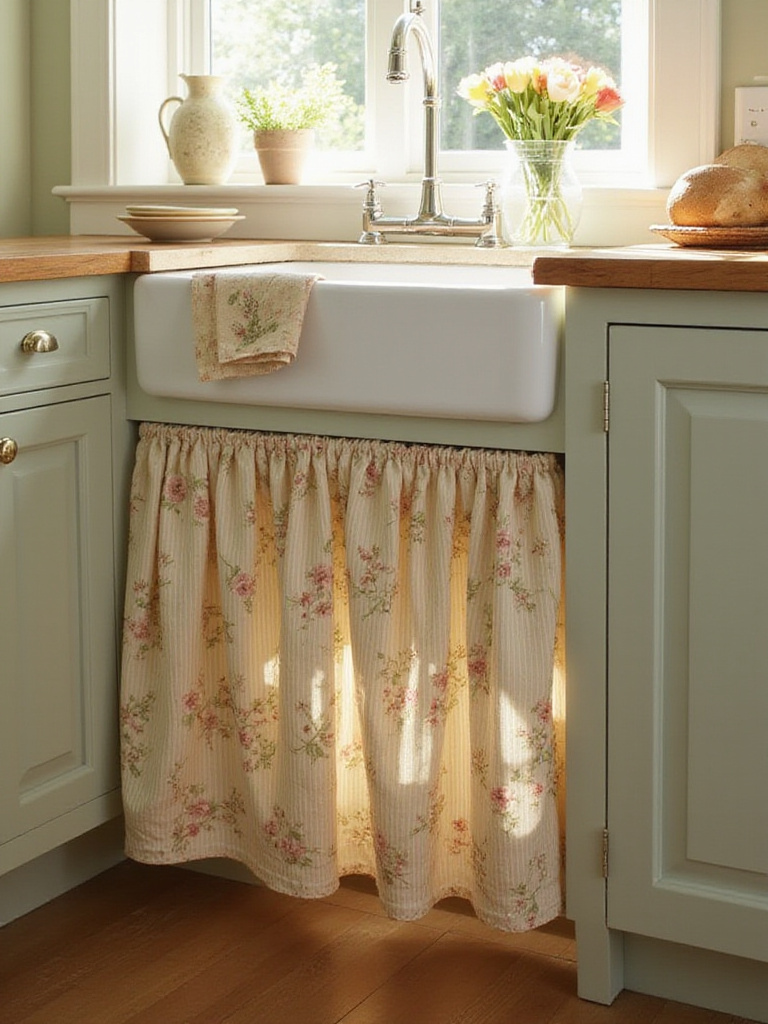
Creating a sink skirt involves selecting durable, washable fabric that complements your kitchen’s color palette and installing it using simple hardware like tension rods or Velcro strips. The key to a professional appearance lies in choosing fabric with appropriate weight and fullness – typically 1.5 to 2 times the width of the opening for proper gathering. Consider water-resistant fabrics or treatments if your under-sink area tends toward dampness, and remember that this is an opportunity to introduce pattern or color that ties together other elements in your kitchen. The beauty of a fabric skirt lies in its flexibility – you can easily change it seasonally or as your style evolves, making it a low-commitment way to experiment with different looks.
Beyond concealing storage, displaying functional items as decoration creates another layer of authentic cottage charm.
13. Hang Pots and Pans for Functional Display
Displaying your cookware on wall-mounted racks or ceiling-hung systems transforms necessary kitchen tools into decorative elements while solving storage challenges and improving cooking efficiency. This approach celebrates the tools of cooking rather than hiding them away, creating an authentic working-kitchen atmosphere that embodies the cottage philosophy of finding beauty in everyday functionality. The visual weight and varied shapes of hanging pots and pans add interest to wall spaces while keeping essential items within easy reach of your cooking areas.
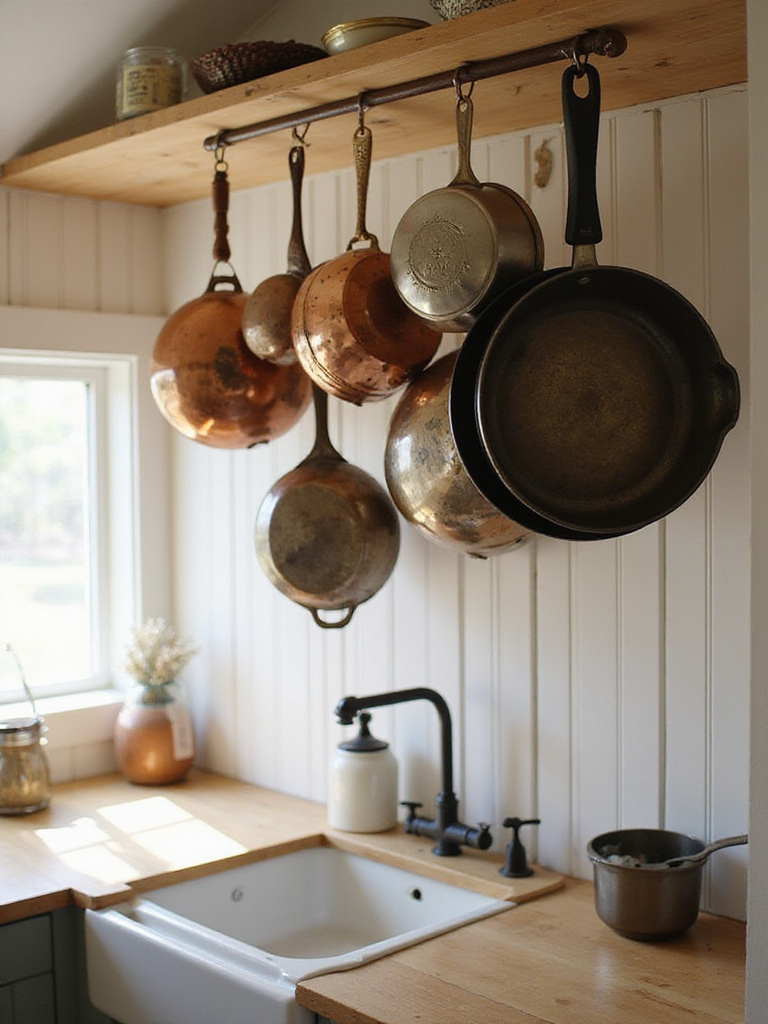
The success of hanging cookware depends on selecting appropriate hardware that can safely support the cumulative weight while complementing your cottage aesthetic. Wall-mounted rails with S-hooks offer flexibility and easy installation, while ceiling-mounted pot racks create dramatic focal points over islands or peninsulas. The key considerations include proper anchoring to wall studs or ceiling joists, strategic placement to avoid head bumps, and thoughtful arrangement that balances visual weight while prioritizing frequently used items in the most accessible positions. Beautiful cookware like copper pots or well-seasoned cast iron becomes part of your kitchen’s decoration, while less attractive pieces can remain in traditional storage.
Just as functional items can become decorative, proper lighting transforms your cottage kitchen from merely charming to truly magical.
14. Hang Pendant Lights for Warm Ambiance
Pendant lighting serves as both functional task lighting and atmospheric enhancement, creating pools of warm illumination that define spaces and establish mood in your cottage kitchen. The strategic placement of pendants over islands, peninsulas, or sink areas provides focused light for food preparation while contributing to the layered lighting scheme essential for creating cozy, inviting spaces. The fixture styles you choose – from glass globes and metal shades to woven baskets and vintage-inspired designs – become decorative elements that reinforce your cottage aesthetic while serving practical needs.
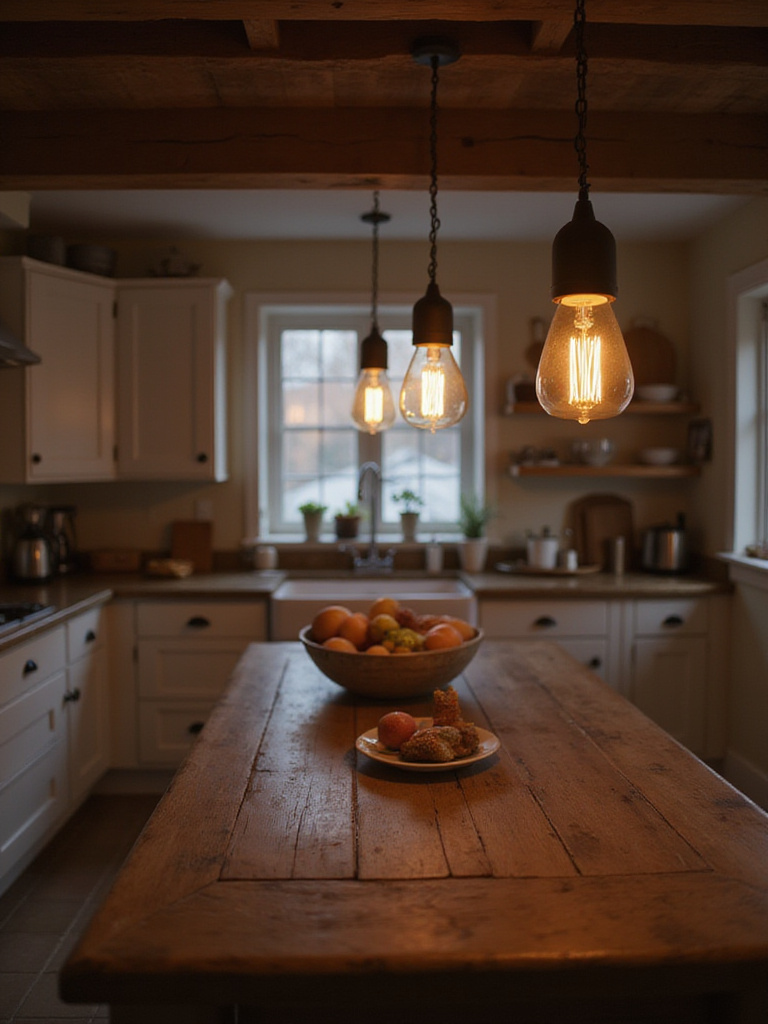
The magic of pendant lighting lies in its ability to create intimate zones within the larger kitchen space, using warm light temperatures (2700K-3000K) that promote feelings of comfort and relaxation. Proper installation height is crucial – typically 30-36 inches above countertops – to provide adequate task lighting without obstructing sight lines or creating glare. Installing dimmer switches allows you to adjust the ambiance from bright task lighting during food preparation to soft ambient lighting for evening conversations. The interplay between pendant lights and natural light throughout the day creates an ever-changing atmosphere that keeps your cottage kitchen feeling dynamic and alive.
As evening light creates its own magic, softening your windows with fabric adds another layer of cottage comfort.
15. Soften Windows with Charming Fabric Curtains
Window treatments in cottage kitchens serve multiple purposes: they provide privacy, filter harsh sunlight, and introduce essential textile elements that soften the hard surfaces typical of kitchen environments. Cafe curtains, valances, or simple panels in natural fabrics like linen, cotton, or lightweight wool add texture and visual warmth while maintaining the casual, unfussy aesthetic that defines cottage style. The gentle movement of fabric in natural breezes and the way curtains filter and diffuse light throughout the day contribute to the dynamic, living quality that makes cottage kitchens so appealing.
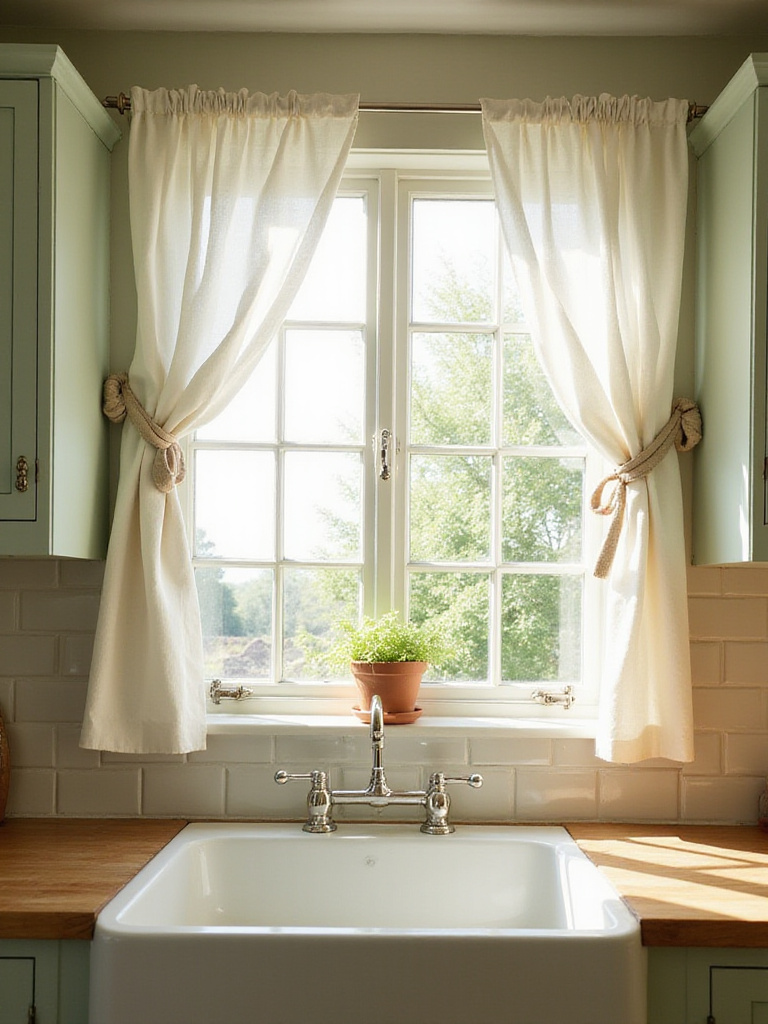
Selecting the right window treatments requires balancing practical needs with aesthetic goals, considering factors like privacy requirements, light control, and maintenance demands. Kitchen curtains face unique challenges from cooking vapors, humidity, and potential splashing, making washable fabrics essential. Simple styles work best – elaborate treatments can appear overdone in the casual cottage setting and may collect grease and odors. The key is choosing fabrics and patterns that complement your overall color scheme while adding visual interest through texture or subtle pattern. Gingham, small florals, stripes, or natural linen textures all work beautifully in cottage settings, providing that essential softness that transforms windows from architectural elements into welcoming focal points.
Beyond the windows, bringing comfort to the floor level creates another opportunity to enhance the cozy cottage atmosphere.
16. Layer a Cozy Area Rug for Added Comfort
A thoughtfully chosen area rug transforms hard kitchen flooring into a more comfortable and visually warm surface, providing both physical comfort for extended standing periods and aesthetic softness that balances the harder materials typical of kitchen environments. The right rug can define spaces within your kitchen, create visual boundaries, and introduce color, pattern, or texture that ties together your cottage design elements. More than mere decoration, a kitchen rug serves as a practical comfort measure that makes daily cooking tasks more pleasant while contributing to the layered, collected look that characterizes cottage style.
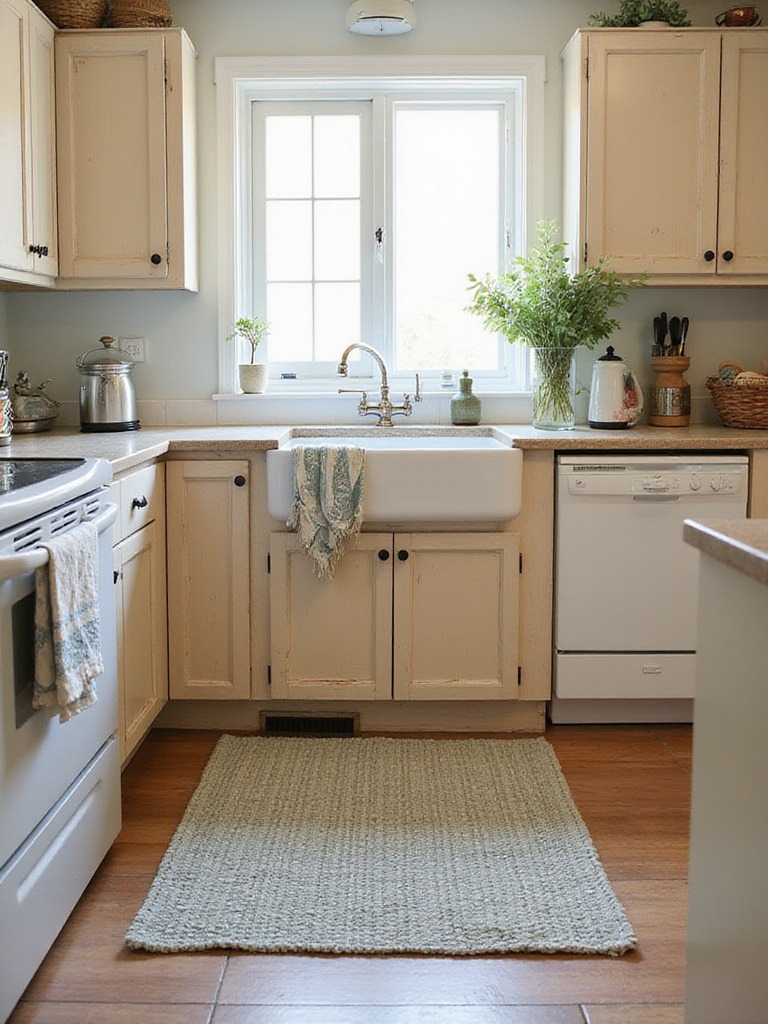
Selecting a kitchen rug requires careful consideration of both style and practicality, as these pieces must withstand spills, frequent foot traffic, and regular cleaning while maintaining their appearance and safety. Look for rugs specifically designed for high-traffic areas, with materials like washable cotton, low-pile wool, or stain-resistant synthetics that can handle kitchen conditions. Size and placement are crucial – the rug should be large enough to feel substantial but not so large as to interfere with cabinet doors or create tripping hazards. A non-slip pad underneath is essential for safety, while choosing colors and patterns that complement your cottage palette helps integrate the rug seamlessly into your overall design scheme.
With comfort established underfoot, creating dedicated seating areas maximizes both function and charm in your cottage kitchen.
17. Create a Cozy Nook with Bench Seating
A built-in bench nook transforms an underutilized corner or wall space into a charming dining area that maximizes seating while adding significant cottage character to your kitchen. This space-efficient solution provides comfortable seating for family meals, casual conversations, or quiet moments with morning coffee, creating a designated gathering spot that enhances the social function of your kitchen. The intimate scale of a breakfast nook, combined with the cozy feeling of built-in seating, perfectly embodies the cottage philosophy of creating spaces that feel both functional and nurturing.

The design possibilities for bench seating are endless, from simple straight benches along one wall to L-shaped configurations that maximize corner spaces or even U-shaped arrangements that create intimate dining rooms within the kitchen footprint. Built-in storage beneath the seats adds valuable space for linens, seasonal items, or rarely used kitchen equipment, while comfortable cushions and pillows introduce color, pattern, and essential softness. The key to a successful nook lies in proper proportions – ensuring adequate table space, comfortable seat depth and height, and sufficient clearance for easy access. Adding personal touches through textile choices, lighting, and decorative elements makes the nook feel like a special destination within your kitchen rather than just additional seating.
While seating areas provide spots for relaxation, bringing living elements into your kitchen adds vitality and freshness to the cottage atmosphere.
18. Bring Life In with Potted Herbs and Plants
Living plants and fresh herbs introduce vibrant life and natural beauty to cottage kitchens while serving practical purposes that enhance both cooking and daily well-being. The presence of greenery softens architectural lines, adds organic shapes and textures, and creates focal points that change and grow over time. Fresh herbs like basil, rosemary, thyme, and mint provide immediate access to flavor enhancers while filling your kitchen with natural fragrances that make cooking more pleasurable and the space more inviting.

The key to successful kitchen gardening lies in understanding your space’s specific conditions and selecting plants accordingly. South-facing windows provide ideal conditions for sun-loving herbs like basil and oregano, while north-facing exposures suit lower-light plants like pothos or snake plants. Kitchen environments offer unique advantages for plant growth, including higher humidity near sinks and dishwashers, but also present challenges like temperature fluctuations and potential exposure to cooking vapors. Grouping plants together increases local humidity and creates more impactful displays, while choosing containers that complement your cottage aesthetic – terracotta pots, vintage crocks, or galvanized buckets – integrates your green elements seamlessly into your overall design scheme.
Just as plants bring natural life to your kitchen, displaying meaningful collections adds personal history and character.
19. Display Vintage Finds and Collections Openly
Openly displaying vintage finds and personal collections transforms your cottage kitchen from a merely functional space into a reflection of your personality and history. These carefully curated items – whether antique rolling pins, vintage mixing bowls, or collections of transferware – add layers of visual interest while telling the story of your tastes and travels. The patina and character marks of well-loved vintage pieces bring an authenticity that new items cannot replicate, contributing to that essential “collected over time” feeling that defines cottage style.
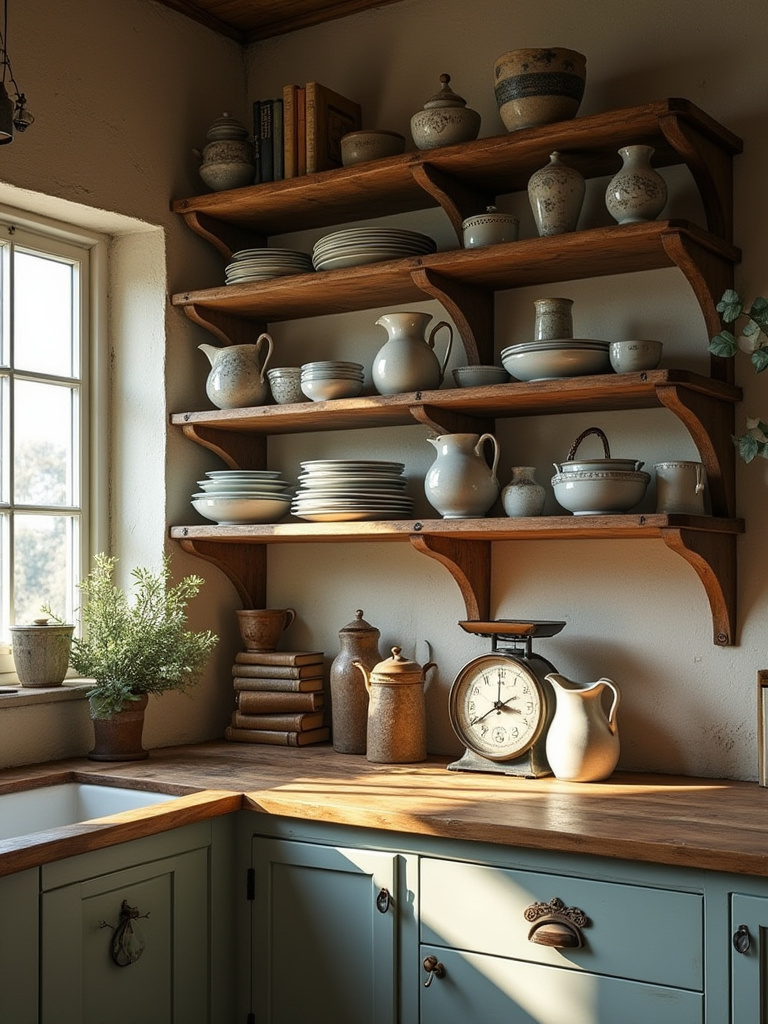
The art of displaying collections lies in thoughtful curation and strategic placement that enhances rather than clutters your space. Group items by color, material, or theme to create cohesive vignettes, vary heights and depths to add visual interest, and leave breathing room around displays to prevent overwhelming the eye. Consider the practical aspects of kitchen display – items near cooking areas will require more frequent cleaning, while pieces on high shelves should be securely positioned. The goal is creating moments of discovery and delight throughout your kitchen, where each glance reveals new details and connections between your displayed treasures and the overall cottage aesthetic.
The artisans behind these designs began with traditional materials, leading us to explore how reclaimed wood can add authentic character to modern cottage kitchens.
20. Incorporate Reclaimed Wood Elements for Character
Reclaimed wood brings unmatched character and authenticity to cottage kitchens, offering textures, colors, and imperfections that tell stories of previous lives and uses. Whether incorporated as open shelving, island cladding, ceiling beams, or accent walls, these weathered materials add instant history and visual weight that grounds your space in tradition. The varied grain patterns, nail holes, and gentle wear marks of reclaimed lumber create focal points that feel genuinely aged rather than artificially distressed, contributing to the authentic cottage aesthetic that celebrates materials with history.
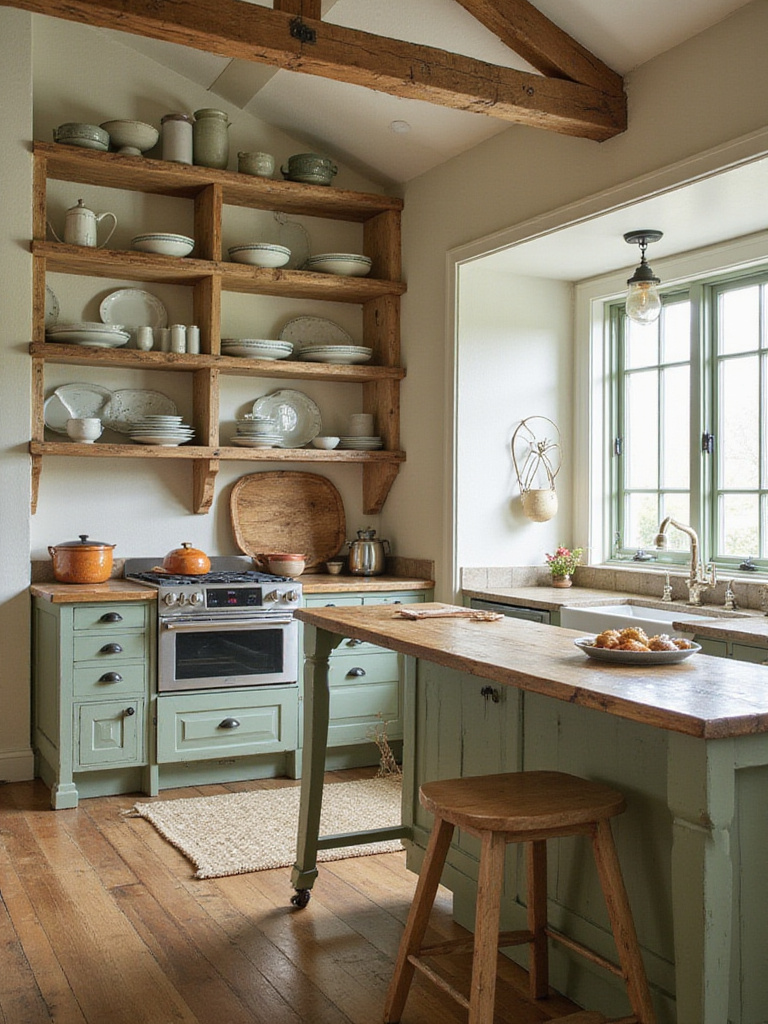
The process of incorporating reclaimed wood requires careful sourcing and preparation to ensure both safety and longevity in kitchen environments. Reputable suppliers provide documentation of origin and treatment, while proper cleaning, inspection, and sealing protect against pests and moisture damage. The key to successful integration lies in balancing reclaimed elements with cleaner, more refined materials – pairing rough-hewn beams with painted cabinetry, or combining weathered shelving with polished countertops. This contrast prevents the space from feeling too rustic while highlighting the unique character of the reclaimed pieces. Consider the scale and placement carefully, as reclaimed wood makes a strong visual statement that works best when used strategically rather than overwhelmingly.
While reclaimed wood adds horizontal character elements, installing picture rails provides elegant solutions for vertical display opportunities.
21. Add a Picture Rail to Display Artwork
A picture rail offers an elegant solution for displaying artwork and decorative items without creating multiple holes in your cottage kitchen walls, while adding authentic architectural detail that enhances the period character of your space. This traditional feature, commonly found in older homes, allows for flexible arrangement and rearrangement of artwork, family photos, or seasonal decorations using adjustable hanging systems rather than permanent wall anchors. The clean horizontal line of a picture rail also helps define wall proportions and adds visual interest to plain surfaces.
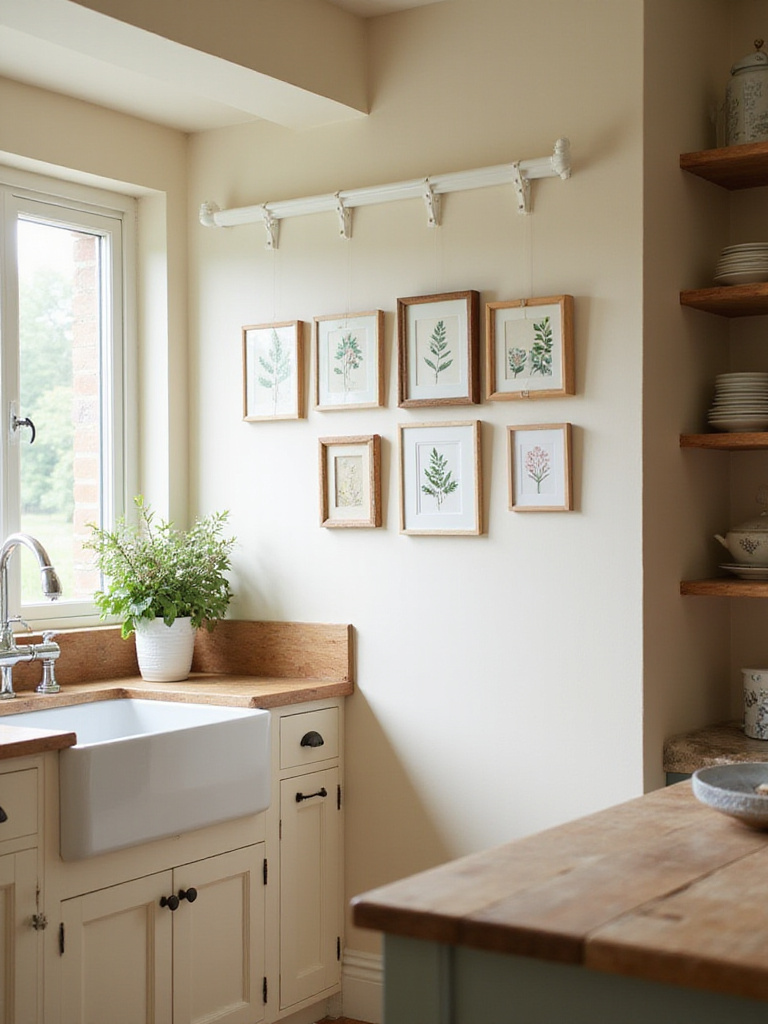
Installing a picture rail requires careful planning to ensure proper height and level placement, typically 12-24 inches below the ceiling or at door frame height for optimal visual impact. The rail itself becomes part of your room’s architectural vocabulary, so selecting a profile that complements your existing trim and molding maintains design coherence. The beauty of this system lies in its flexibility – you can easily swap artwork seasonally, adjust heights for different pieces, or completely rearrange your display without any wall damage. This adaptability makes picture rails particularly valuable in kitchens where you might want to change decorative elements more frequently than in other rooms, allowing your space to evolve with your tastes and seasons.
Finally, creating dedicated spaces for relaxation completes the cottage kitchen’s transformation from purely functional to truly livable.
22. Build a Window Seat for a Charming Reading Nook
A built-in window seat transforms an ordinary window area into a charming retreat that serves multiple functions while maximizing your cottage kitchen’s potential. This feature creates a cozy spot for morning coffee, afternoon reading, or quiet conversation while providing valuable hidden storage beneath the seat. The combination of natural light, comfortable seating, and storage functionality embodies the cottage principle of making every element both beautiful and useful, creating spaces that enhance daily living rather than merely looking attractive.
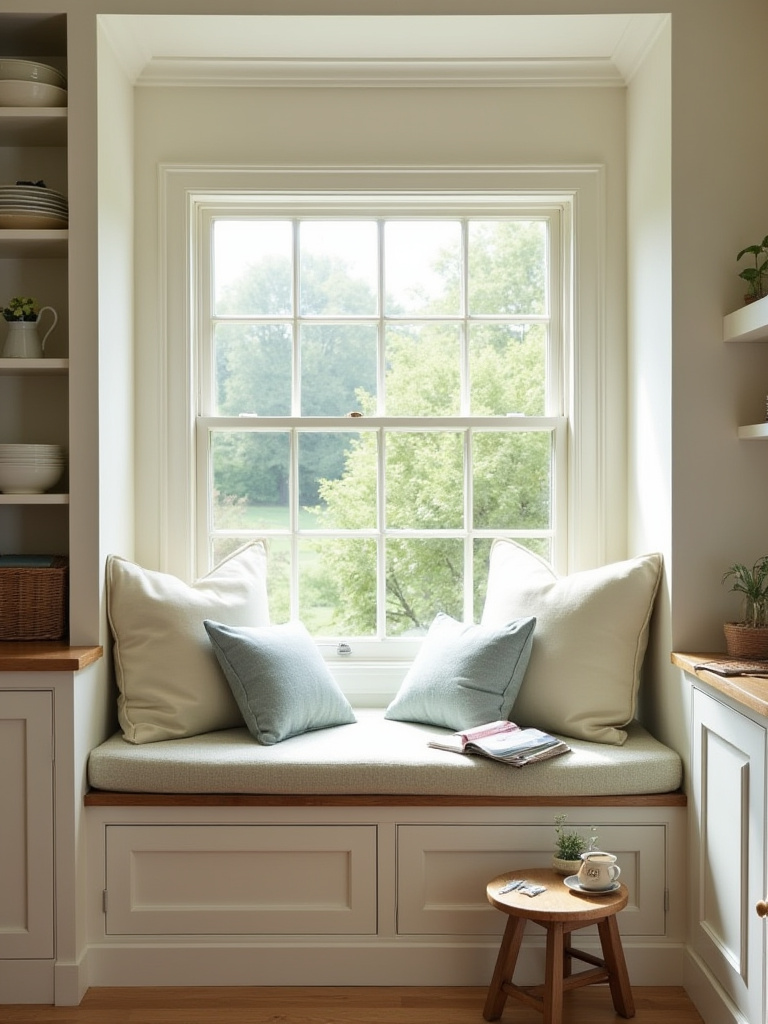
The construction of a window seat requires careful planning to ensure proper proportions, adequate support, and seamless integration with your existing architecture. The ideal seat height ranges from 16-18 inches with cushions, while depth should be at least 16 inches for comfortable seating. Storage options include lift-top designs for linens and seasonal items, or drawer systems for more organized access to contents. The finishing details – from paint color and hardware to cushion fabrics and pillow selections – provide opportunities to reinforce your cottage aesthetic while creating a truly inviting spot that becomes a favorite gathering place for family and friends.
Conclusion
Creating your dream cottage kitchen is a journey of layering warmth, character, and functionality to build a space that truly feels like the heart of your home. These 22 cottage kitchen ideas demonstrate that achieving this beloved aesthetic doesn’t require a complete renovation or unlimited budget – it’s about understanding the elements that create charm and implementing them thoughtfully throughout your space.
From the foundational choices like warm wall colors and farmhouse sinks to the finishing touches of vintage hardware and displayed collections, each element contributes to building that coveted cottage atmosphere. The magic lies in the combination: soft pastels that reflect light, natural materials that add warmth, open storage that displays your personality, and comfortable seating that invites lingering. These cottage kitchen ideas work together to create spaces that feel collected over time rather than decorated overnight.
Remember that your cottage kitchen should reflect your personal story and lifestyle needs. Start with one or two elements that resonate most strongly with you – perhaps painting your cabinets in a gentle sage green or adding open shelving to display your grandmother’s china. As you implement these cottage kitchen ideas, you’ll discover how each addition builds upon the others, creating a space that welcomes family and friends while making every day feel a little more special. Your cozy dream kitchen awaits, ready to become the gathering place where memories are made and traditions begin.

